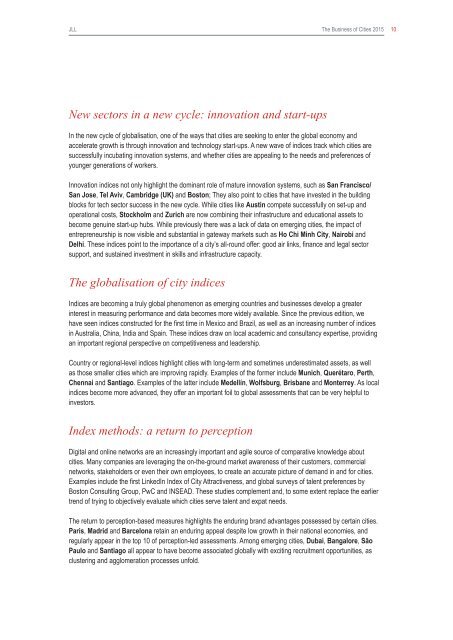The Business of Cities 2015
jll-business-of-cities-report
jll-business-of-cities-report
You also want an ePaper? Increase the reach of your titles
YUMPU automatically turns print PDFs into web optimized ePapers that Google loves.
JLL<br />
<strong>The</strong> <strong>Business</strong> <strong>of</strong> <strong>Cities</strong> <strong>2015</strong> 10<br />
New sectors in a new cycle: innovation and start-ups<br />
In the new cycle <strong>of</strong> globalisation, one <strong>of</strong> the ways that cities are seeking to enter the global economy and<br />
accelerate growth is through innovation and technology start-ups. A new wave <strong>of</strong> indices track which cities are<br />
successfully incubating innovation systems, and whether cities are appealing to the needs and preferences <strong>of</strong><br />
younger generations <strong>of</strong> workers.<br />
Innovation indices not only highlight the dominant role <strong>of</strong> mature innovation systems, such as San Francisco/<br />
San Jose, Tel Aviv, Cambridge (UK) and Boston; <strong>The</strong>y also point to cities that have invested in the building<br />
blocks for tech sector success in the new cycle. While cities like Austin compete successfully on set-up and<br />
operational costs, Stockholm and Zurich are now combining their infrastructure and educational assets to<br />
become genuine start-up hubs. While previously there was a lack <strong>of</strong> data on emerging cities, the impact <strong>of</strong><br />
entrepreneurship is now visible and substantial in gateway markets such as Ho Chi Minh City, Nairobi and<br />
Delhi. <strong>The</strong>se indices point to the importance <strong>of</strong> a city’s all-round <strong>of</strong>fer: good air links, finance and legal sector<br />
support, and sustained investment in skills and infrastructure capacity.<br />
<strong>The</strong> globalisation <strong>of</strong> city indices<br />
Indices are becoming a truly global phenomenon as emerging countries and businesses develop a greater<br />
interest in measuring performance and data becomes more widely available. Since the previous edition, we<br />
have seen indices constructed for the first time in Mexico and Brazil, as well as an increasing number <strong>of</strong> indices<br />
in Australia, China, India and Spain. <strong>The</strong>se indices draw on local academic and consultancy expertise, providing<br />
an important regional perspective on competitiveness and leadership.<br />
Country or regional-level indices highlight cities with long-term and sometimes underestimated assets, as well<br />
as those smaller cities which are improving rapidly. Examples <strong>of</strong> the former include Munich, Querétaro, Perth,<br />
Chennai and Santiago. Examples <strong>of</strong> the latter include Medellín, Wolfsburg, Brisbane and Monterrey. As local<br />
indices become more advanced, they <strong>of</strong>fer an important foil to global assessments that can be very helpful to<br />
investors.<br />
Index methods: a return to perception<br />
Digital and online networks are an increasingly important and agile source <strong>of</strong> comparative knowledge about<br />
cities. Many companies are leveraging the on-the-ground market awareness <strong>of</strong> their customers, commercial<br />
networks, stakeholders or even their own employees, to create an accurate picture <strong>of</strong> demand in and for cities.<br />
Examples include the first LinkedIn Index <strong>of</strong> City Attractiveness, and global surveys <strong>of</strong> talent preferences by<br />
Boston Consulting Group, PwC and INSEAD. <strong>The</strong>se studies complement and, to some extent replace the earlier<br />
trend <strong>of</strong> trying to objectively evaluate which cities serve talent and expat needs.<br />
<strong>The</strong> return to perception-based measures highlights the enduring brand advantages possessed by certain cities.<br />
Paris, Madrid and Barcelona retain an enduring appeal despite low growth in their national economies, and<br />
regularly appear in the top 10 <strong>of</strong> perception-led assessments. Among emerging cities, Dubai, Bangalore, São<br />
Paulo and Santiago all appear to have become associated globally with exciting recruitment opportunities, as<br />
clustering and agglomeration processes unfold.








